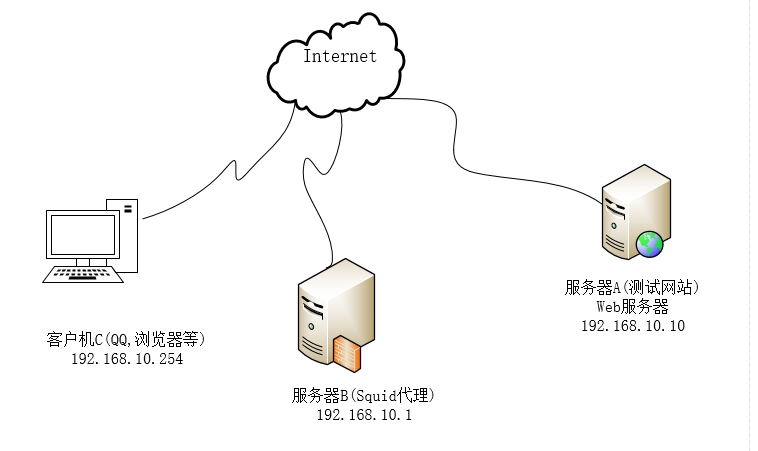构建squid代理服务器
基本概念
本文使用squid代理服务
软件介绍:百度百科
作为应用层的代理服务软件,Squid主要提供缓存加速、应用层过滤控制的功能;
工作机制:缓存网页对象,减少重复请求(HTTP代理的缓存加速对象主要为文字、图像等静态Web元素);
代理类型:
- 传统代理:适用于Internet,需明确指定服务端;
- 透明代理:适用于共享上网网关,不需指定服务端;
使用代理的优点:
- 提高Web访问速度;
- 隐藏客户机的真实IP地址;
其他可以实现数据缓存的软件:
本文不过多介绍
编译安装Squid软件&&基本使用
软件软件下载地址:http://www.squid-cache.org/
1.编译安装软件
tar zxvf squid-3.4.6.tar.gz -C /usr/src/ //解包 cd /usr/src/squid-3.4.6/ ./configure --prefix=/usr/local/squid --sysconfdir=/etc/ --enable-arp-acl --enable-linux-netfiulter --enable-linux-tproxy --enable-async-io=100 --enable-err-language="Simplify_Chinese" --enable-underscore --enable-poll --enable-gunregex //配置,更多配置可以参考"./configure --help" make && make install //编译并安装
ln -s /usr/local/squid/sbin/* /usr/local/sbin/ #优化执行路径
useradd -M -s /sbin/nologin squid #创建程序用户
chown -R squid:squid /usr/local/squid/var/ #更改指定目录额属主和属组 chmod -R 757 /usr/local/squid/var/ #修改指定目录的权限,以便写入日志
配置项说明:

--prefix=/usr/local/squid //安装目录; --sysconfdir=/etc/ //单独将配置文件修改到其他目录下; --enable-arp-acl //可以在规则中设置直接通过客户端MAC进行管理,防止客户端使用IP欺骗; --enable-linux-netfiulter //使用内核过滤; --enable-linux-tproxy //支持透明模式; --enable-async-io=100 //异步I/O,提升存储性能,相当于--enable-pthreads --enable-storeis=ufs,aufs --with-pthreads --with-aufs-thread=值; --enable-err-language="Simplify_Chinese" //错误信息的显示语言; --enable-underscore //允许URL中有下划线; --enable-poll //使用Poll()模式,提升性能; --enable-gunregex //使用GNU正则表达式;
配置文件内容:
位置::/etc/squid.conf(更详细的配置项请参考/etc/squid.conf.documented文件)

# # Recommended minimum configuration: # # Example rule allowing access from your local networks. # Adapt to list your (internal) IP networks from where browsing # should be allowed acl localnet src 10.0.0.0/8 # RFC1918 possible internal network acl localnet src 172.16.0.0/12 # RFC1918 possible internal network acl localnet src 192.168.0.0/16 # RFC1918 possible internal network acl localnet src fc00::/7 # RFC 4193 local private network range acl localnet src fe80::/10 # RFC 4291 link-local (directly plugged) machines acl SSL_ports port 443 acl Safe_ports port 80 # http acl Safe_ports port 21 # ftp acl Safe_ports port 443 # https acl Safe_ports port 70 # gopher acl Safe_ports port 210 # wais acl Safe_ports port 1025-65535 # unregistered ports acl Safe_ports port 280 # http-mgmt acl Safe_ports port 488 # gss-http acl Safe_ports port 591 # filemaker acl Safe_ports port 777 # multiling http acl CONNECT method CONNECT # # Recommended minimum Access Permission configuration: # # Deny requests to certain unsafe ports http_access deny !Safe_ports # Deny CONNECT to other than secure SSL ports http_access deny CONNECT !SSL_ports # Only allow cachemgr access from localhost http_access allow localhost manager http_access deny manager # We strongly recommend the following be uncommented to protect innocent # web applications running on the proxy server who think the only # one who can access services on "localhost" is a local user #http_access deny to_localhost # # INSERT YOUR OWN RULE(S) HERE TO ALLOW ACCESS FROM YOUR CLIENTS # # Example rule allowing access from your local networks. # Adapt localnet in the ACL section to list your (internal) IP networks # from where browsing should be allowed http_access allow localnet http_access allow localhost # And finally deny all other access to this proxy http_access deny all # Squid normally listens to port 3128 http_port 3128 //用来指定代理服务监听的地址和端口(默认端口为3128) # Uncomment and adjust the following to add a disk cache directory. #cache_dir ufs /usr/local/squid/var/cache/squid 100 16 256 # Leave coredumps in the first cache dir coredump_dir /usr/local/squid/var/cache/squid # # Add any of your own refresh_pattern entries above these. # refresh_pattern ^ftp: 1440 20% 10080 refresh_pattern ^gopher: 1440 0% 1440 refresh_pattern -i (/cgi-bin/|\?) 0 0% 0 refresh_pattern . 0 20% 4320
Squid运行控制:
squid -k parse //检查配置文件语法是否正确
squid //开启服务
squid -k kill //停止服务
squid -z //初始化缓存目录(清理缓存目录**服务停止的情况下)
更多的使用方法请参考:http://linux.51yip.com/search/squid
创建Squid服务脚本:
github address:https://github.com/spdir/ShellScripts/blob/master/squid.sh

#!/bin/bash # chkconfig: 2345 90 25 #可以使用-,-的意思是所有运行级别 # config: /etc/squid.conf # pidfile: /usr/local/squid/var/run/squid.pid # Description: Squid - Internet Object Cache PID="/usr/local/squid/var/run/squid.pid" #程序运行才会有pid文件,反之则无 CONF="/etc/squid.conf" CMD="/usr/local/squid/sbin/squid" case "$1" in start) netstat -anpt | grep squid $> /dev/null if [ $? -eq 0 ] then echo "Squid is running" else $CMD fi ;; stop) $CMD -k kill $> /dev/null #调用squid命令停止服务 rm -rf $PID $> /dev/null #删除pid文件 ;; status) [ -f $PID ] &> /dev/null #检测pid文件是否存在 if [ $? -eq 0 ] #假如文件存在则0等于0,执行netstat命令展示端口 then netstat -aupt | grep squid else echo "Squid is not running" fi ;; restart) $0 stop $> /dev/null #注意:$0 stop的意思是调用之前定义的stop echo "正在关闭Squid..." $0 start $> /dev/null echo "正在启动Squid..." ;; reload) $CMD -k reconfigure #重新加载,但不中断服务,配置更改后,建议用这种方式加载 ;; check) $CMD -k parse #检查配置文件语法是否错误 ;; *) echo "用法:$0 {start | stop | restart | reload | check | status}" # $0代表脚本名字/etc/squid.conf的用法 ;; esac
将这个文件放到/etc/init.d/目录下并命名为squid
chmod +x /etc/init.d/squid //赋予执行权限 chkconfig --add squid //添加到系统服务 chkconfig squid on
这样我们就可以通过squid脚本来启动、停止、重启、重载Squid服务了。
构建传统代理服务

案例环境说明:
- 主机B提供Web代理服务
- 主机C通过代理访问主机A的网站
Squid服务器配置:
vim /etc/squid.conf //修改配置文件 省略...... http_access allow all //放在http_access deny all 之前 http_port 3128 reply_body_max_size 10 MB //允许下载的最大文件大小(10MB)[可选] 省略......
在防火墙中添加允许策略:(在实验环境中可以选择直接关闭防火墙)
iptables -I INPUT -p tcp --dport 3128 -j ACCEPT service iptables save iptables:将防火墙规则保存到 /etc/sysconfig/iptables: [确定]
重载Squid服务
service squid reload
客户机的代理配置
windows客户端:

linux客户端:
vim /etc/profile

http_proxy=http://192.168.10.1:3128 # 分别指定http、https、ftp协议使用的代理服务器地址 https_proxy=http://192.168.10.1:3128 ftp_proxy=http://192.168.10.1:3128 no_proxy=192.168.10. # 访问局域网地址(192.168.20.0/24网段)时不使用代理,可以用逗号分隔多个地址 export http_proxy https_proxy ftp_proxy no_proxy
source /etc/profile //立即生效
代理服务的验证方式:
在客户机192.168.10.254中通过浏览器访问目标网站 http://192.168.10.10/ 然后观察Squid代理服务器、Web服务器的访问日志,以验证代理服务是否发挥作用。
构建透明代理

案例环境说明:
- Linux网关提供透明代理服务
- 局域网通过代理访问Internet中的网站
配置Squid支持透明代理:
vim /etc/squid.conf //修改squid配置文件 省略...... http_port 192.168.10.1:3128 tranparent //只在其中一个IP地址上提供服务 省略......
设置iptables的重定向策略
REDIRETC也是一种数据包控制类型,只能在nat表的PREROUTIN或OUTPUT链以及被调用的链中使用,通过"--to-prots 端口号"的形式来指定映射的目标端口。
iptables -t nat -I PREROUTING - eth1 -s 192.168.10.0/24 -p tcp --dport 80 -j REDIRECT --to-prots 3128 //http iptables -t nat -I PREROUTING - eth1 -s 192.168.10.0/24 -p tcp --dport 443 -j REDIRECT --to-prots 3128 //https service iptables save iptables:将防火墙规则保存到 /etc/sysconfig/iptables: [确定]
3.验证透明代理的使用
为了验证透明代理的效果,如果手动指定的代理服务器设置应在客户机中将其去除。
linux客户机中的取出方式通过Unset命令清除http_proxy,https_proxy
unset http_proxy https_proxy
验证方式:(和传统的方式相同)
在客户机192.168.10.254中通过浏览器访问目标网站 http://192.168.10.10/ 然后观察Squid代理服务器、Web服务器的访问日志,以验证代理服务是否发挥作用。
未完待续......


